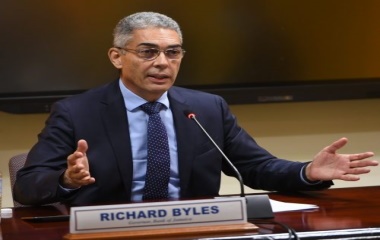KINGSTON, Jamaica, CMC – Governor of the Bank of Jamaica (BOJ), Richard Byles, says the country’s economy continues to grow but at a more moderate rate
Byles, speaking at the release of the Quarterly Monetary Policy Report, said that real gross domestic product (GDP) for the financial year 2023/24 is estimated to have grown between 1.5 and 2.5 percent, and the economy is expected to grow in the June 2024 quarter, albeit at a slower pace.
“The Bank projects that real GDP will increase by 1.0 to 2.0 percent for the financial year 2024/25. This growth is projected to be broad-based with modest increases in Hotels & Restaurants and its allied industries, Mining & Quarrying, Agriculture, Forestry & Fishing, Manufacture, and Electricity & Water Supply,” Byles said.
The Governor said that, on average, over the 12-month period ending in April, the Jamaican dollar depreciated against the US dollar by 1.4 percent, continuing the fairly stable trend over the last two years.
“There was, however, an uptick in the pace of depreciation in April, which primarily resulted from a seasonal increase in demand following the end of the March tax season. To prevent undue volatility in the foreign exchange market, BOJ has sold approximately US$983 million…over the 12 months to end-April 2024.”
He said that when these sales were set against BOJ purchases, the result was that the Bank net purchased approximately US$1.3 billion over the period, resulting in a NIR (average interest rate)of US$5.1 billion as of the end of April 2024.
Byles said the pace of depreciation slowed over the first two weeks of May, and the BOJ will continue to act to ensure orderly movements in the exchange rate.
He said consistent with these developments and reflecting continued confidence in the Jamaican dollar, DTI (debt to income ratio) deposit dollarisation, measured by the proportion of DTIs’ United States (US) dollar deposits to total deposits, has moderated.
He said to support the stability in the exchange rate, the BOJ continues to maintain tight Jamaican dollar liquidity.
“This stance is reflected in higher yields on the Bank’s 30-day CD and increases in private money market rates. For example, the average yield on BOJ’s 30-Day CD has fluctuated between 10 to 11 percent over the past six months.”
Byles said the BOJ’s primary mandate is to see inflation firmly anchored between four and six percent, adding, “We remain resolute in this commitment.”
He said that last month, the BOJ received written confirmation from the Minister of Finance and the Public Service, Dr. Nigel Clarke, that Jamaica’s inflation target will be maintained at four to six percent for the next three years.
“This inflation target is a major policy instrument for Jamaica’s government and an important guidance tool for the entire economy. The target is the anchor that underpins how individuals and businesses should view current and future changes in the general level of prices in the economy. The determination of the target by the Minister followed consultation with the Central Bank.”
Byles said that the BOJ’s recommendation to maintain the inflation target at four to six percent cents “reflects our view that this target is generally consistent with the country’s economic structure and stage of economic development.
“Jamaica would not wish to have higher inflation. Lower inflation is desirable but is difficult to achieve in the near term for several reasons. The first is that Jamaica has a weak monetary transmission mechanism.”
He said limited competition in the banking sector is among the primary constraints on the transmission mechanism in Jamaica, particularly via the credit channel.
Byles said the dominant players hold high levels of low-cost saving deposits, which makes their funding cost less sensitive to the Central Bank’s policy actions.
“This limits the ability of the central Bank to target a lower inflation without significant economic and social costs. By way of example, we assess that, with the existing system, the Central Bank would have to raise interest rates to double digits to contain inflation below four percent, which would dramatically increase financing costs and reduce financing opportunities.”
The BOJ Governor said these actions would also reduce the government’s ability to achieve the targeted reduction in the debt-to-GDP ratio by pushing up interest costs on GOJ debt.
“It is also important that the targeted inflation rate enables nominal GDP to grow at a rate consistent with the country’s debt reduction strategy. Targeting a lower inflation rate is also hampered by low factor productivity. A highly productive economy produces goods and services at lower unit costs, which dampens inflation.”
Byles said that, on the other hand, lower productivity means that goods and services will become relatively more expensive over time, which makes it more difficult to reduce inflation.
























































 and then
and then